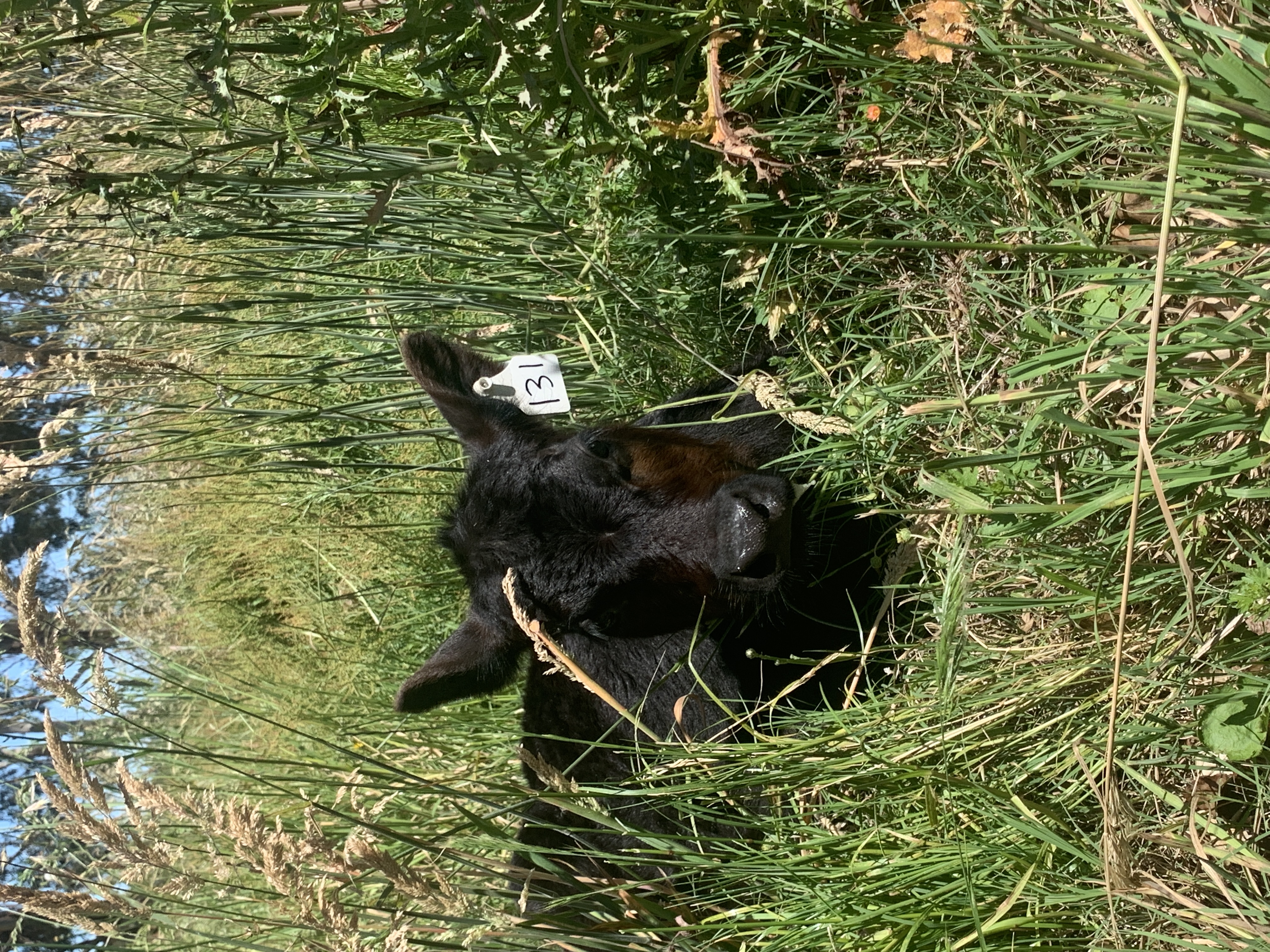|
Rennet
Rennet () is a complex set of enzymes produced in the stomachs of ruminant mammals. Chymosin, its key component, is a protease enzyme that curdles the casein in milk. In addition to chymosin, rennet contains other enzymes, such as pepsin and a lipase. Rennet has traditionally been used to separate milk into solid curds and liquid whey, used in the production of cheeses. Rennet from calves has become less common for this use, to the point that less than 5% of cheese in the United States is made using animal rennet today. Most cheese is now made using chymosin derived from bacterial sources. Molecular action of rennet enzymes One of the main actions of rennet is its protease chymosin cleaving the kappa casein chain. Casein is the main protein of milk. Cleavage causes casein to stick to other cleaved casein molecules and form a network. It can cluster better in the presence of calcium and phosphate. This is why those chemicals are occasionally added to supplement pre-exist ... [...More Info...] [...Related Items...] OR: [Wikipedia] [Google] [Baidu] |
Chymosin
Chymosin or rennin is a protease found in rennet. It is an aspartic endopeptidase belonging to MEROPS A1 family. It is produced by newborn ruminant animals in the lining of the abomasum to curdle the milk they ingest, allowing a longer residence in the bowels and better absorption. It is widely used in the production of cheese. Bovine chymosin is now produced recombinantly in , '' Aspergillus niger var awamori'', and as alternative resource. Occurrence The chymosin is found in a wide range of tetrapods, although it is best known to be produced by ruminant animals in the lining of the abomasum. Chymosin is produced by gastric chief cells in newborn mammals to curdle the milk they ingest, allowing a longer residence in the bowels and better absorption. Non-ruminant species that produce chymosin include pigs, cats, seals,Staff, Online Mendelian Inheritance in Man (OMIM) Database. Last updated February 21, 199Chymosin pseudogene; CYMP prochymosin, included, in the OMIM/ref> an ... [...More Info...] [...Related Items...] OR: [Wikipedia] [Google] [Baidu] |
Whey
Whey is the liquid remaining after milk has been curdled and strained. It is a byproduct of the manufacturing of cheese or casein and has several commercial uses. Sweet whey is a byproduct resulting from the manufacture of rennet types of hard cheese, like cheddar or Swiss cheese. Acid whey (also known as sour whey) is a byproduct brought out during the making of acid types of dairy products, such as strained yogurt. Whey proteins consist of α-lactalbumin, β-lactoglobulin, serum albumin, immunoglobulins, and proteose peptones. Composition Whey protein is the collection of globular proteins isolated from whey. The protein in cow's milk is 20% whey protein and 80% casein protein, whereas the protein in human milk is 60% whey and 40% casein. The protein fraction in whey constitutes approximately 10% of the total dry solids in whey. This protein is typically a mixture of beta-lactoglobulin (~48-58%), alpha-lactalbumin (~13-19%), bovine serum albumin (~6%)(see also ser ... [...More Info...] [...Related Items...] OR: [Wikipedia] [Google] [Baidu] |
Curds
Curd is obtained by coagulating milk in a sequential process called curdling. It can be a final dairy product or the first stage in cheesemaking. The coagulation can be caused by adding rennet or any edible acidic substance such as lemon juice or vinegar, and then allowing it to coagulate. The increased acidity causes the milk proteins (casein) to tangle into solid masses, or ''curds''. Milk that has been left to sour (raw milk alone or pasteurized milk with added lactic acid bacteria) will also naturally produce curds, and sour milk cheeses are produced this way. Producing cheese curds is one of the first steps in cheesemaking; the curds are pressed and drained to varying amounts for different styles of cheese and different secondary agents (molds for blue cheeses, etc.) are introduced before the desired aging finishes the cheese. The remaining liquid, which contains only whey proteins, is the whey. In cow's milk, 90 percent of the proteins are caseins. Curds can be used ... [...More Info...] [...Related Items...] OR: [Wikipedia] [Google] [Baidu] |
Protease
A protease (also called a peptidase, proteinase, or proteolytic enzyme) is an enzyme that catalyzes (increases reaction rate or "speeds up") proteolysis, breaking down proteins into smaller polypeptides or single amino acids, and spurring the formation of new protein products. They do this by cleaving the peptide bonds within proteins by hydrolysis, a reaction where water breaks bonds. Proteases are involved in many biological functions, including digestion of ingested proteins, protein catabolism (breakdown of old proteins), and cell signaling. In the absence of functional accelerants, proteolysis would be very slow, taking hundreds of years. Proteases can be found in all forms of life and viruses. They have independently evolved multiple times, and different classes of protease can perform the same reaction by completely different catalytic mechanisms. Hierarchy of proteases Based on catalytic residue Proteases can be classified into seven broad groups: * Serine prot ... [...More Info...] [...Related Items...] OR: [Wikipedia] [Google] [Baidu] |
Abomasum
The abomasum, also known as the maw,The Chambers Dictionary, Ninth Edition, Chambers Harrap Publishers, 2003 rennet-bag, or reed tripe, is the fourth and final stomach compartment in ruminants. It secretes , which is used in creation. The word ''abomasum'' (''ab-'' "away from" + '' [...More Info...] [...Related Items...] OR: [Wikipedia] [Google] [Baidu] |
Calf (animal)
A calf ( : calves) is a young domestic cow or bull. Calves are reared to become adult cattle or are slaughtered for their meat, called veal, and hide. The term ''calf'' is also used for some other species. See " Other animals" below. Terminology "Calf" is the term used from birth to weaning, when it becomes known as a ''weaner'' or ''weaner calf'', though in some areas the term "calf" may be used until the animal is a yearling. The birth of a calf is known as ''calving''. A calf that has lost its mother is an orphan calf, also known as a ''poddy'' or ''poddy-calf'' in British. ''Bobby calves'' are young calves which are to be slaughtered for human consumption. A ''vealer'' is a calf weighing less than about which is at about eight to nine months of age. A young female calf from birth until she has had a calf of her own is called a ''heifer'' (). In the American Old West, a motherless or small, runty calf was sometimes referred to as a dodie. The term "calf" is also used fo ... [...More Info...] [...Related Items...] OR: [Wikipedia] [Google] [Baidu] |
Veal
Veal is the meat of calves, in contrast to the beef from older cattle. Veal can be produced from a calf of either sex and any breed, however most veal comes from young male calves of dairy breeds which are not used for breeding. Generally, veal is more expensive by weight than beef from older cattle. Veal production is a way to add value to dairy bull calves and to utilize whey solids, a byproduct from the manufacturing of cheese. Definitions and types There are several types of veal, and terminology varies by country. Similar terms are used in the US, including calf, bob, intermediate, milk-fed, and special-fed. Culinary uses In Italian, French and other Mediterranean cuisines, veal is often in the form of cutlets, such as the Italian '' cotoletta'' or the famous Austrian dish Wiener Schnitzel. Some classic French veal dishes include fried '' escalopes'', fried veal ''Grenadines'' (small, thick fillet steaks), stuffed '' paupiettes'', roast joints, an ... [...More Info...] [...Related Items...] OR: [Wikipedia] [Google] [Baidu] |
Curdling
Curdling is the breaking of an emulsion or colloid into large parts of different composition through the physio-chemical processes of flocculation, creaming, and coalescence. Curdling is purposeful in the production of cheese curd and tofu; undesirable in the production of a sauce, cheese fondue or a custard. Method In curdling, the pH of the milk decreases and becomes more acidic. Independently floating casein molecules attract one another, forming "curdles" that float in a translucent whey. At warmer temperatures, the clumping reaction occurs more quickly than at colder temperature. Curdling occurs naturally if cows' milk is left open in a warm environment to air for a few days. Cheese and tofu Milk and soy milk are curdled intentionally to make cheese and tofu by the addition of enzymes (typically rennet), acids (including lemon juice), or various salts (magnesium chloride, calcium chloride, or gypsum); the resulting curds are then pressed. Egg sauces In hot prep ... [...More Info...] [...Related Items...] OR: [Wikipedia] [Google] [Baidu] |
Casein
Casein ( , from Latin ''caseus'' "cheese") is a family of related phosphoproteins ( αS1, aS2, β, κ) that are commonly found in mammalian milk, comprising about 80% of the proteins in cow's milk and between 20% and 60% of the proteins in human milk. Sheep and buffalo milk have a higher casein content than other types of milk with human milk having a particularly low casein content. Casein has a wide variety of uses, from being a major component of cheese, to use as a food additive. The most common form of casein is sodium caseinate. In milk, casein undergoes phase separation to form colloidal casein micelles, a type of secreted biomolecular condensate. As a food source, casein supplies amino acids, carbohydrates, and two essential elements, calcium and phosphorus. Composition Casein contains a high number of proline amino acids which hinder the formation of common secondary structural motifs of proteins. There are also no disulfide bridges. As a result, it has relatively ... [...More Info...] [...Related Items...] OR: [Wikipedia] [Google] [Baidu] |
Pepsin
Pepsin is an endopeptidase that breaks down proteins into smaller peptides. It is produced in the gastric chief cells of the stomach lining and is one of the main digestive enzymes in the digestive systems of humans and many other animals, where it helps digest the proteins in food. Pepsin is an aspartic protease, using a catalytic aspartate in its active site. It is one of three principal endopeptidases (enzymes cutting proteins in the middle) in the human digestive system, the other two being chymotrypsin and trypsin. There are also exopeptidases which remove individual amino acids at both ends of proteins ( carboxypeptidases produced by the pancreas and aminopeptidases secreted by the small intestine). During the process of digestion, these enzymes, each of which is specialized in severing links between particular types of amino acids, collaborate to break down dietary proteins into their components, i.e., peptides and amino acids, which can be readily absorbed by t ... [...More Info...] [...Related Items...] OR: [Wikipedia] [Google] [Baidu] |
Casein
Casein ( , from Latin ''caseus'' "cheese") is a family of related phosphoproteins ( αS1, aS2, β, κ) that are commonly found in mammalian milk, comprising about 80% of the proteins in cow's milk and between 20% and 60% of the proteins in human milk. Sheep and buffalo milk have a higher casein content than other types of milk with human milk having a particularly low casein content. Casein has a wide variety of uses, from being a major component of cheese, to use as a food additive. The most common form of casein is sodium caseinate. In milk, casein undergoes phase separation to form colloidal casein micelles, a type of secreted biomolecular condensate. As a food source, casein supplies amino acids, carbohydrates, and two essential elements, calcium and phosphorus. Composition Casein contains a high number of proline amino acids which hinder the formation of common secondary structural motifs of proteins. There are also no disulfide bridges. As a result, it has relatively ... [...More Info...] [...Related Items...] OR: [Wikipedia] [Google] [Baidu] |
.jpg)

.jpg)



.jpg)

